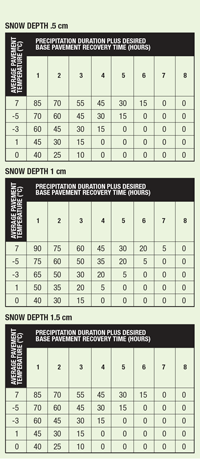August 29, 2016

Research update: Snow and ice control in parking lots
BY DR. TAIMUR USMAN
In countries with severe winters such like Canada, winter snow storms are a source of concern for transportation officials and the general public alike. Snowfall and ice formation on pavement surfaces deteriorate driving conditions, causing significant reduction in pavement friction and thereby causing safety and mobility problems. Pavement surface conditions are restored using winter road maintenance activities such as plowing and salting. However, winter maintenance operations also incur significant costs and negative environmental effects.
 Every year, Canada spends over $1 billion to clear snow and ice on public and private roads, parking lots and sidewalks. This includes the use of over five million tonnes of salts for deicing and anti-icing operations. These estimates do not include significant indirect costs such as damage to the environment, road infrastructure, and vehicles due to salt use. The environmental impact of salting has also been widely recognized, and research by Environment Canada concludes that salting for maintenance at high concentrations poses a risk to plants, animals and aquatic systems.
Every year, Canada spends over $1 billion to clear snow and ice on public and private roads, parking lots and sidewalks. This includes the use of over five million tonnes of salts for deicing and anti-icing operations. These estimates do not include significant indirect costs such as damage to the environment, road infrastructure, and vehicles due to salt use. The environmental impact of salting has also been widely recognized, and research by Environment Canada concludes that salting for maintenance at high concentrations poses a risk to plants, animals and aquatic systems.Because of these significant financial, environmental, and social implications, considerable research and development efforts have been devoted to the improvement of winter maintenance methods, products, and technologies over the past decades. However, most of the past efforts have focused on roadway maintenance, with little research on parking lots and sidewalks — which account for up to 30 per cent of all salt usage. Though we do have guidelines and standards for winter maintenance when it comes to roads, none was available for parking lots or sidewalks.
Given this background, a research project was initiated by a request from the Snow and Ice Sector Group of Landscape Ontario, recognizing the need for a systematic study to address common questions facing every winter maintenance contractor: what is the right deicing or anti-icing material, and how much should be applied under a given condition?
The first step in the process to gain was an understanding of the current practice of parking-lot maintenance contractors; over 200 municipalities in Canada and the U.S. were surveyed. Building on this knowledge, a comprehensive testing strategy was developed by Dr. Liping Fu (the principal investigator for this project) and his research team, and over recent years data from more than 100 sites have been used to model bare pavement recovery time as a function of salt application rate and other weather variables. The modelling results are shown in the accompanying table.
Later on, different adjustment factors were developed to account for different snow types, traffic levels, alternative salts, effects of pre-wetting and pavement types. These tests were, however, conducted more or less in a semi-controlled environment. To validate the results from the previous years, data from the winter of 2015-2016 will be used. Data has been collected from 14 sites across Kitchener-Waterloo, Ont., for different parking lots (in terms of area and functionality) for this past winter season. The main objective is to field-validate the models developed earlier and fine tune the adjustment factors under real world environments. The research team is currently working on compiling and organizing the data from winter 2015-2016, following which a detailed analysis will be carried out. The final findings will be made available at www.sicops.ca before the winter 2016-17.
PAVEMENT TEMPERATURE, TIME AND RATES TABLE (see above left)
The tables show that if the average pavement surface temperature is -3° C, then to melt 1 cm of snow, reaching bare pavement within four hours, the minimum application rate should be around 20 lbs. per 1,000 sq. ft. All data for regular snow with a density of 100 kg per cubic meter.
Dr. Taimur Usman is a post-doctoral fellow at the Innovative Transportation System Solutions Lab, University of Waterloo. A large number of researchers have contributed to the success of this project, including two post-doctoral fellows, four full-time graduate researchers, and over 24 co-op students. This project has been made possible with the financial and logistic support of many organizations from both the government and the private sectors, including Landscape Ontario, GO Transit, Toronto Region Conservation Authority (TRCA), Natural Sciences and Engineering Research Council of Canada (NSERC), Ontario Ministry of Transportation (MTO), Snow and Ice Management Association (SIMA), and a number of private contractors from across Ontario.